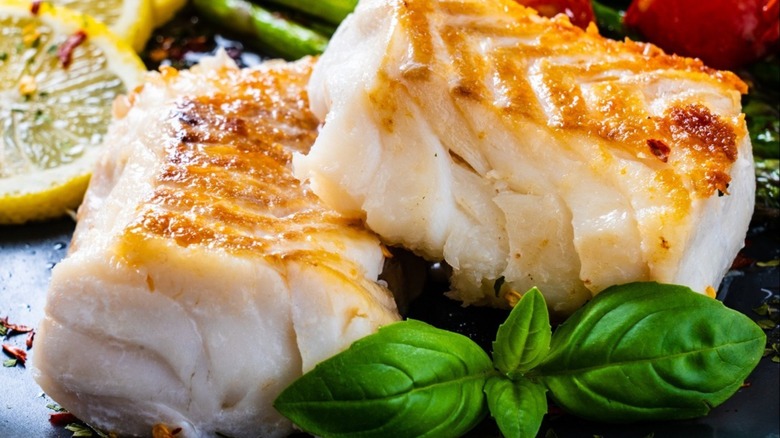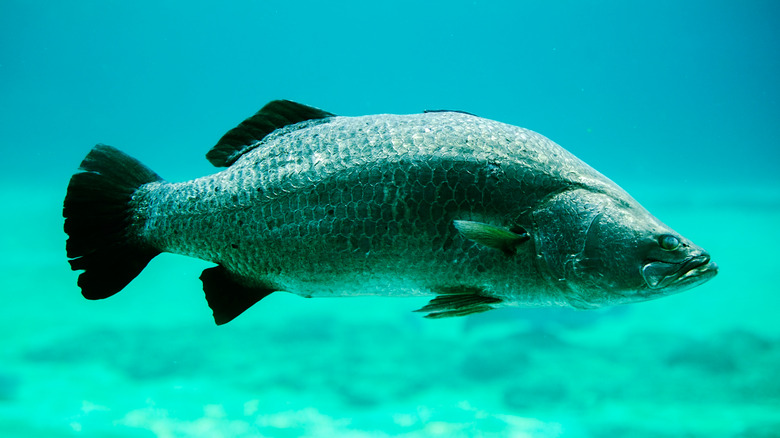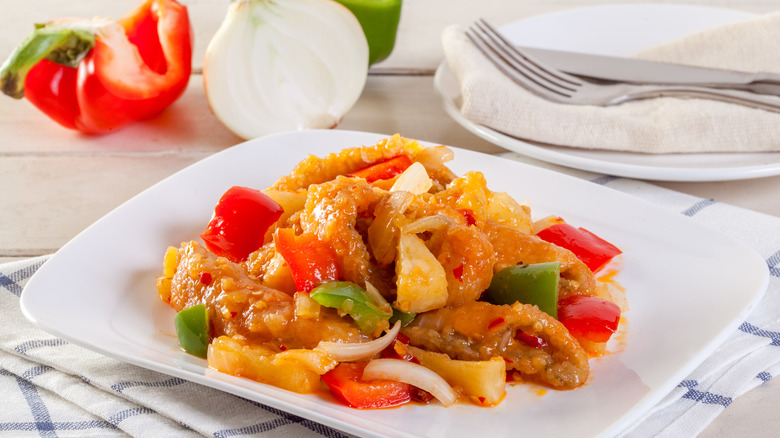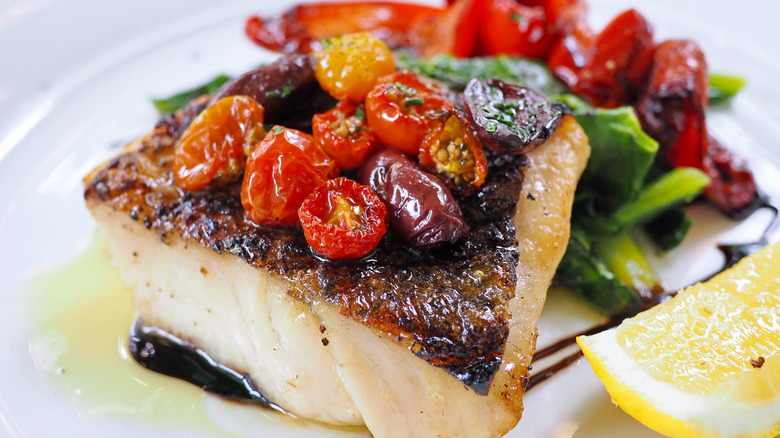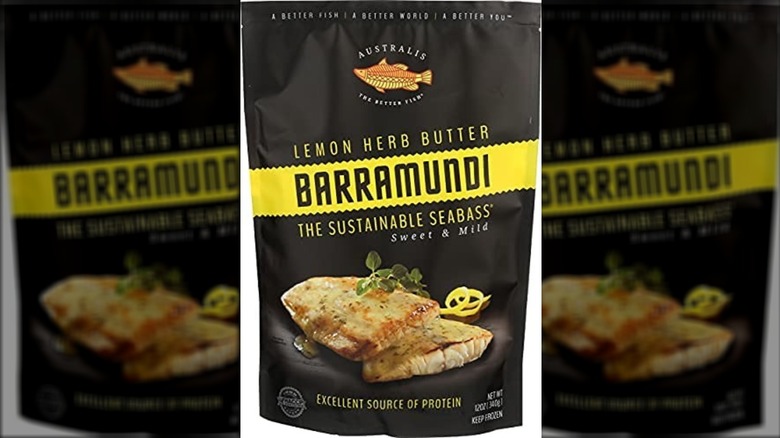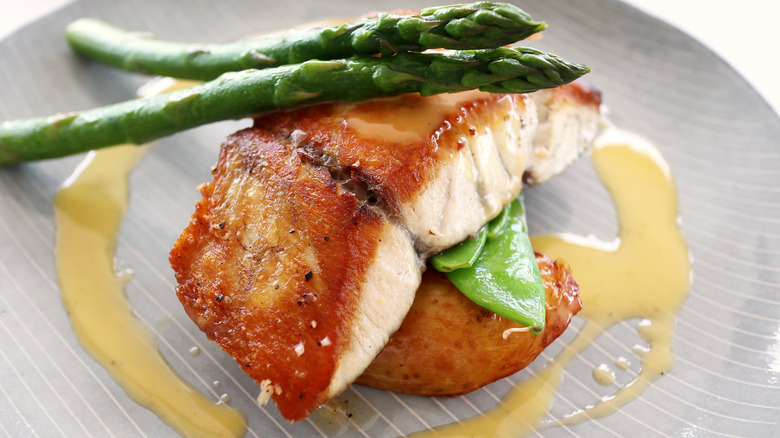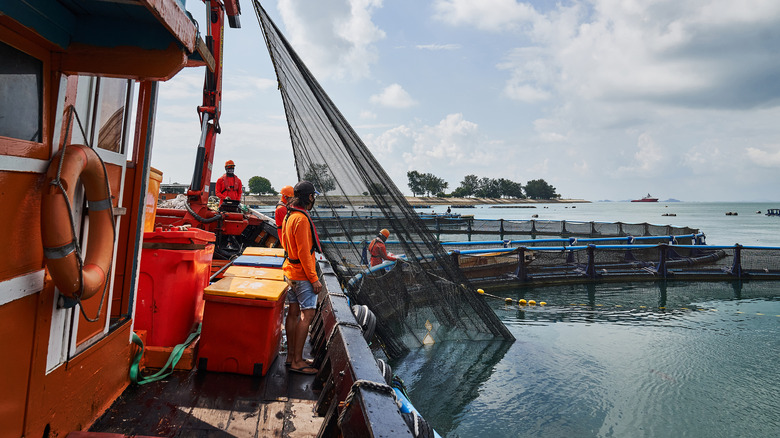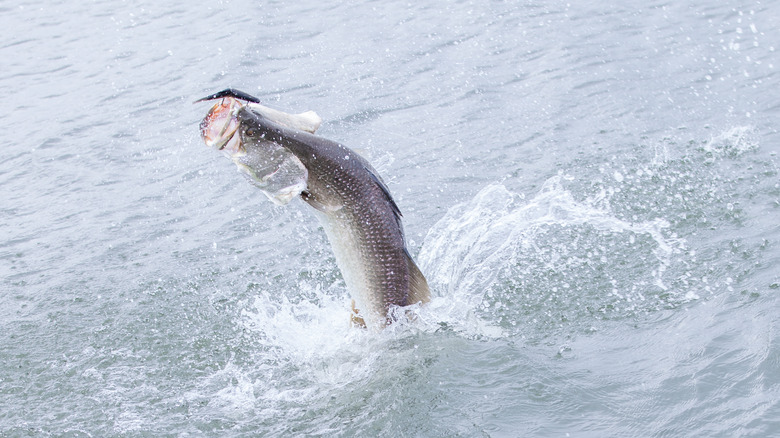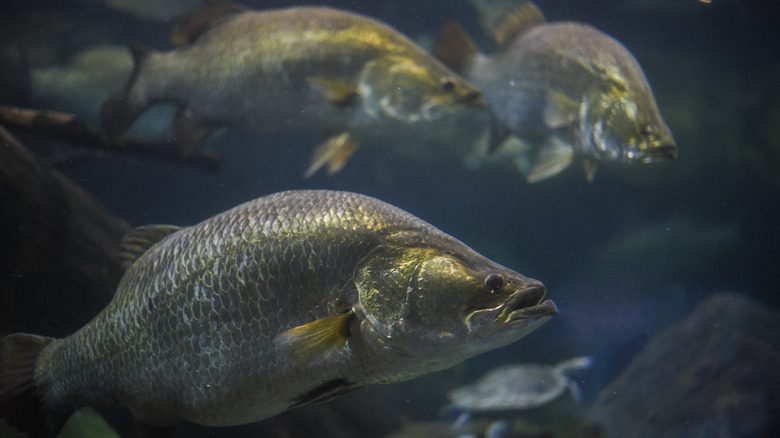What Is Barramundi And What Does It Taste Like?
While barramundi isn't quite a household word just yet, expect that to change in the near future. Why? Because this lesser-known species is about to become the sustainable seafood savior we've all been waiting for. Seafood is popular throughout the world. The global demand for seafood has risen over the years, and on average 143.8 million metric tons are thought to be consumed each year, as per Your Fish Guide. Including other uses of seafood, the overall total is reportedly 154 million metric tons.
Unfortunately, the worldwide fish supply is in a bit of trouble, with the seafood industry fearing poor management of the oceans will result in the inability to meet demand. In less than 30 years, The Better Fish suggests that there may not be nearly enough of some of the world's most popular fish species to go around. Some of the planet's most common fish include the silver carp, common carp, and bighead carp (via World Atlas), but overfishing could one day wipe them out. Here's where the barramundi comes in. This species may be able to help with the impending fish shortage due to its ability to flourish without antibiotics or hormones.
What is barramundi?
Barramundi, or Lates calcarifer to be scientifically correct, sounds almost like a beautiful tropical island. It is an Asian sea bass that The Better Fish says belongs to the family Latidrae and the order Perciformes. It is widely available and popular in South Asia, Papua New Guinea, and northern Australia. Barramundi is a white-fleshed fish similar to trout rather than a pink-fleshed one like salmon.
Although barramundi is eaten all over the Indo-Pacific region, its name actually comes from the Australian Aboriginal language (via The Spruce Eats). The name barramundi translates to "large-scaled river fish," which is pretty spot-on for this kind of fish. The barramundi does have scales and the fish, as well as its scales, is incredibly large. In fact, Fish Choice says they can reach 7 feet long and tip the scales at 130 pounds. This means that one barramundi can feed a whole crowd, something that will help to make them the fish of the future.
What does barramundi taste like?
The Better Fish says Barramundi has a subtle, gentle, and mild flavor that makes it a perfect gateway fish for those who may not already be seafood fans. It has a rich, buttery, soft, and slightly sweet flavor, according to Fish Choice. The smell is also on the mild side. While some people don't care for fish due to the strong odor it gives off, this is less of a problem with barramundi as it's not so fishy-smelling as, say, salmon or tuna.
Gourmet Traveller says that one of the best things about barramundi is its versatility. Its white flesh and mild flavor lend themselves well to all manner of preparations and make it something you can use as an ingredient in a variety of dishes, including curries, mango and coconut salad, and steamed barramundi with rice. Much like any other fish these days, barramundi is flash-frozen once caught, meaning it can be easily stored in your freezer and taken out whenever you're ready to cook it.
How to cook with barramundi
Barramundi has a high fat content which makes cooking it fairly easy. You can grill, roast, boil, saute, bake, steam, and fry barramundi. No matter your level of cooking expertise, one of those options is bound to work for you. One simple preparation method for barramundi would be to pan-fry it. Start by patting the skin of the fish dry to ensure a crisp exterior. Once the fish is dry, you can make shallow cuts into the skin, being careful not to go deep enough to hit the flesh. These cuts will help keep the skin from shriveling up as you cook it (via Recipe Tin Eats). Season the barramundi with salt and pepper, rubbing it into the slits in the skin, then heat the fish on a lightly-oiled pan for two to three minutes per side. If your barramundi is extra-thick, you may need to finish cooking it in the oven until the internal temperature reaches 131 F.
Barramundi can also be sauteed with butter and herbs, grilled with Thai seasonings, or cooked with butter, lemon, and/or wine. If you want to bake barramundi, The Better Fish suggests covering whole fish or fillets with a sauce made of garlic, white wine, butter, lemon, capers, salt, and pepper, then cooking it at 375 F for about 15 to 18 minutes until the flesh is firm and white.
Where to buy barramundi
Barramundi may not be available in every supermarket just yet, but that is starting to change. Some of the major chains that do carry barramundi on a regular basis include Whole Foods Market, BJ's Club, Costco, Safeway, Albertson's, Harris Teeter, Freshy Thyme, Giant Eagle, and Market Basket. Not all locations will have barramundi on hand at all times, and there are also many other stores that carry it that we did not list. Your best bet to find barramundi is to use the store locator tool on The Better Fish's website and then to follow up with a call to your local store to see whether they currently have any of this fish in stock.
Much of the barramundi available in stores will be sold bagged and frozen so you won't really be able to examine the fish before you buy it. Fish Choice does provide the caveat that not all frozen barramundi are created equal since production and harvesting methods may impact the quality. They advise you to steer clear of pond-raised barramundi if at all possible, as they feel this type of fish may have an "off-flavor."
Nutritional information about barramundi
While it seems like just about anything that's not drenched in fat or sugar is being touted as a superfood these days, Barramundi is something that actually makes a fairly good case for itself to earn this accolade. While this fish does have a relatively high fat content (5 grams per piece), more than half (3 grams) of this is unsaturated (via The Better Fish). Barramundi also has half the calories of salmon – only about 185 calories per one fillet. And, like most fish, it doesn't have any carbs or sugars. It is a great source of lean protein, with a 6-ounce serving providing 34 grams of the stuff.
Barramundi is also rich in omega-3 fatty acids, a much-needed part of our diets. One serving of barramundi can contain as much as 1 gram of omega-3 fatty acids, as per Livestrong. The benefits don't stop there! Six ounces contain 40 milligrams of calcium and 4% of an adult's daily vitamin A intake. As a bonus, barramundi is a fairly worry-free fish, as it is said to contain low levels of mercury or other contaminants.
Barramundi is super-sustainable
The worldwide fishing industry is in big trouble. With underpopulated oceans come poor diets for fish, and there are also biodiversity issues because in many cases only certain fish (tuna, salmon, cod, etc.) are being eaten and others are not. Due to the popularity of certain fish, there is pressure on these specific fish stocks, so unsustainable fishing methods are used to catch them. The Western Australia Department of Fisheries says that barramundi, however, are wide-ranging, adaptable, and very prolific (one female can lay up to 32 million eggs), which makes them less likely to be overfished than are some other species.
Fish farming may seem like a solution to the fishing crisis, but farmed fish can be problematic since hormones and antibiotics may be pumped into the water and thus wind up in the fish. What's more, fish farming can be very expensive due to the fact that some species like salmon need to be fed a diet that includes a lot of other fish – The Spruce Eats estimates that you need 3 pounds of feeder fish to get 1 pound of salmon.
Farmed barramundi, on the other hand, are largely vegetarian. What's more, they can be farmed anywhere, don't create much waste, and, according to GreenBiz, don't need as many antibiotics as other fish. This makes barramundi an attractive prospect for aquaculturists as they are cheaper and more trouble-free to raise than many other species and make for a healthier product.
Barramundi is a favorite fish with millennials
If there's one thing we know about millennials (besides the whole avocado toast thing) it's that they really care about the provenance of what they put in their mouths, particularly when it comes to how it affects the environment. The fact that barramundi is one of the more sustainable types of seafood has not been lost on these consumers, and by the mid-20-teens, Seafood Source says that millennials were driving a rapidly-increasing demand for barramundi in the U.S. that saw it featured on the menus at chain restaurants including Rubio's Coastal Grill and Sizzler Family Restaurants.
Julie Qiu, marketing director with the Massachusetts-based Australis Aquaculture (the nation's largest farmed barramundi supplier as of 2016), thought that some of the increased interest in barramundi was initially sparked by people who'd visited Australia and tasted it there. (Barramundi is big Down Under.) What she felt was really driving the demand, though, was that "Millennials are very much about knowing where their food comes from and investing in products that they can trust and that have a responsibility and sustainability story." She also said they likely appreciate the fact that barramundi is something she calls "manageable and fun to cook at home."
Barramundi get around quite a bit
Barramundi aren't something that U.S.-based sports fishers are likely to get their hooks into anytime soon, although the Western Australia Department of Fisheries says they're really popular with people fishing in Australian waters. Who knows, though, they may get here someday – according to The Better Fish, barramundi are great travelers and have been found to swim hundreds of miles. One barramundi traveled some 400 miles from the spot where it was originally tagged!
In fact, one fun thing about barramundi is that they can be found in both freshwater and saltwater, as well as in estuaries (these are the places where the two types of water meet). Barramundi are actually what you might call catadromous (at least, if you know how to pronounce that word). Catadromous means that they are born in the ocean and live in freshwater, which pretty much makes them the anti-salmon since salmon are born in freshwater and then find their way to the ocean. Not all barramundi get the memo about the freshwater thing, though, since plenty of them spend their whole lives in the briny deep.
Barramundi have an interesting love life
Not only are barramundi pretty open and accepting when it comes to exploring other environments, but nearly all of them get to explore different gender identities, as well. Evidently, most barramundi are born male, then make the transformation to female around the age of 3 or 4. As The Better Fish points out, this means that all barramundi breeding involves younger men/older women pairings.
Barramundi also play a role in an Aboriginal love story. It seems there were once a pair of star-crossed young lovers forbidden to marry so they jumped into the water where they could be together forever by taking the form of barramundi. In fact, the spines that are characteristic of this fish are said to evoke the wooden spears that the twosome used to defend themselves against the angry elders of their tribe before resorting to their watery resting place. This legend has lent the entire species of barramundi the nickname "passion fish," as well as a reputation in certain quarters for having aphrodisiac properties.
